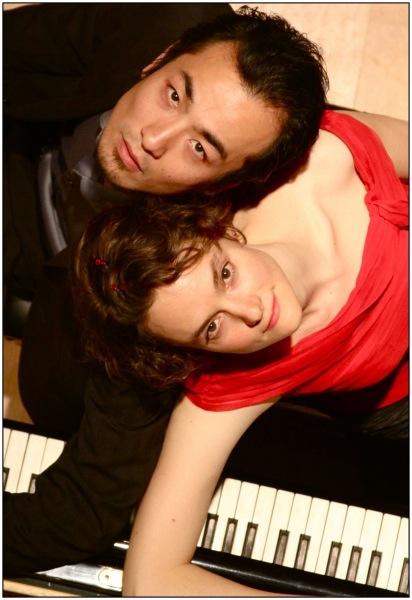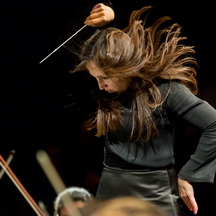
Four hands that beat as one
“You wouldn’t normally dip sushi in melted cheese,” began pianist Eva-Maria Zimmermann, “But you can do that in music, and that is what we have done tonight.” In a program titled “Sushi Fondue,” Zimmermann and fellow pianist Keisuke Nakagoshi traded between Swiss and Japanese composers from the lands of their birth.
Berkeley Chamber Performances brought this extraordinary four-hands piano duo to the Berkeley City Club on Tuesday, February 28, for a reprise of the lively program they created one year ago. Each of these pianists is an acclaimed performer, appearing as soloists across the world, but together one senses that they are out to have a rollicking good time. Their choreography was as beguiling as their music as they reached through and across each other’s arms in a ballet that added a deeply personal touch, and the intensity of their camaraderie was palpable in the music.
Zimmermann introduced the first piece, Frank Martin’s “Overture”: “He left Switzerland for the Netherlands, and was a contemporary of my grandfather, who conducted many of his pieces.” It was an airy collection of bits, with tempos seeming to vary between the hands. A march-like under-chord accentuated the stumbling high line, with its vaguely Rumanian tonality. And then that tonality turned more atonal, before sliding into material whose rhythmic savagery borrowed heavily from Stravinsky. Keisuke’s low notes stiffened into a powerful beat, and Eva-Maria answered with a sharp glitter of high notes.
Keisuke took the microphone to remark on Toshimitsu Tanaka, the composer of An Ancient Five-Storied Pagoda. “When he writes he gets obsessed. When he wrote this piece he was obsessed with the motorbike, and by the time he finished he had covered everywhere in Tokyo. And I think you can hear that here.”
They established a feeling of reverie with slow chords that repeated faster and faster, like a ball dribbling down to logarithmic decay. Eva entered with little traceries of sound, then repeated the “bounced ball” in a high register, and that falling out of singularity into a thrum of merged notes became the motif. A high, quiet melody played out, then repeated over and over for a disjoint moment that was both compellingly lovely and disturbingly obsessive-compulsive.
The “pagoda” explored each story in a lurid movement: Con brio combined low hypnotic chords with bird-warbles whose color was rich in Messiaen. Allegro vivace was frenetic with pounding high notes, but then shifted from cerebral into kinesthesia with a hint of jazz lilt. Tranquillo had a wandering line, but then low chords began to appear and built to a roar. The two pianists sparred with an emphasis on interval, not line, and then finished with a 20-note chord, almost a tone cluster, that died out slowly.
The first half ended with Arthur Honnegger’s “Pastorale d’Été,” a gentle exploration into French coloration and liquid motifs whose slow shifts held a glacial gravity. “This piece evokes the Swiss Alps,” explained Eva, “especially the mountain smells. After coming back from the mountains I used to hide my clothes so that my mother wouldn’t wash them.”
The hints of irreverence came to full fruition in the world premiere of Christian Henking’s “Good morning, John,” a humorous work that Zimmerman had commissioned. Eva-Maria took the bench alone, with Keisuke deferentially to the side. After settling the score she played a bar of pleasant arpeggios, then nodded to Keisuke, who rushed forward to turn the page. With one bar per page, Keisuke was hardly sitting before leaping back up, and so began a war between the pianist and page-turner.
He slyly introduced “random” low notes as he reached for the page, and then began whole passages, to her consternation, pushing his way onto the piano bench. Their “argument” turned vicious, and she pounded out high flurries as he scrummaged the low range. Gradually, he settled into chord versions of her initial arpeggios, while she rampaged across the plinky top notes. And all this was happening while they turned pages at top speed. Then they paused, looked at each other, and reached to turn the page—surprising us with one last note.
What truly impelled the humor was not just the acting, which was perfectly complicit, but the care and complexity of the piece combined with their faultless delivery.
Replete with grand performance and light dessert, it was hard to believe that the best was yet to come. But Tomohiro Moriyama’s “Let’s Play a Duet” mixed serious with sensual for a showstopper. At times notes circled with hypnotic urgency, and then slow balletic swimming led to coy frolics, all flavored with pentatonic scales. The interplay of their arms was strikingly visual, a surprise dimension for a classical concert.
Eva-Maria introduced another fine piece, Dieter Ammann’s “Regard sur les Traditions.” “I met Ammann two years ago. “Looking back at Tradition” is not Mozart but a more recent tradition—Messiaen’s modes and Ligeti. Two rhythms compete with each other, and combined it almost sounds like frogs singing together. The third element is this mechanized movement: it seems that Ammann is like a child playing with things.” (And then they demonstrated.) “The rest is up to you to discover.”
A tentative opening gave way to abrupt little runs and an insectile grumbling. They advanced to the middle for a sharp stop and long-pedaled decay, then repeated runs, grumbles and decays to define a curious alphabet. It was bratty and provocative, and surprisingly gripping.
They ended with Ryuichi Sakamoto’s very accessible “Tong Poo,” which meandered across heavy movie motifs with a light jazz treatment.
ZOFO will perform at the Piedmont Center for the Arts on Saturday, May 12. Mark your calendars!
—Adam Broner
Photo of Eva-Maria Zimmermann and Keisuke Nakagoshi, photo by David Williams.
